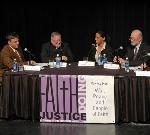First Among Equals
 The U.S. Court of Appeals for the D.C. Circuit is widely seen as the “first among equals” of the U.S. circuit courts. It is the most prominent, it deals with the biggest cases, and its opinions are most highly regarded. This need not necessarily be the case. During the time that Learned Hand (left) and his cousin Augustus sat on the Second Circuit, for instance, the Second Circuit was the most prominent in the land. When the U.S. Supreme Court failed to assemble a quorum to hear an important antitrust case, the Court chose to certify the case to a panel of the Second Circuit for final resolution. Learned Hand authored a significant antitrust decision for the panel in the case (148 F.2d 416), and their power of mandamus was later upheld by the Supreme Court (334 U.S. 258). I have heard it argued that the Ninth Circuit is on the rise to the point where it may soon displace the D.C. Circuit as the most prominent court below the Supreme Court.
The U.S. Court of Appeals for the D.C. Circuit is widely seen as the “first among equals” of the U.S. circuit courts. It is the most prominent, it deals with the biggest cases, and its opinions are most highly regarded. This need not necessarily be the case. During the time that Learned Hand (left) and his cousin Augustus sat on the Second Circuit, for instance, the Second Circuit was the most prominent in the land. When the U.S. Supreme Court failed to assemble a quorum to hear an important antitrust case, the Court chose to certify the case to a panel of the Second Circuit for final resolution. Learned Hand authored a significant antitrust decision for the panel in the case (148 F.2d 416), and their power of mandamus was later upheld by the Supreme Court (334 U.S. 258). I have heard it argued that the Ninth Circuit is on the rise to the point where it may soon displace the D.C. Circuit as the most prominent court below the Supreme Court.
I mention all of this to ask the simple question, prompted by yesterday’s indictment of Governor Blagojevich: Is the Northern District of Illinois the new Southern District of New York? Traditionally, SDNY, as it’s known in the case cites, has been the most prominent of the federal district courts. For instance, Rudy Giuliani left his post as the associate attorney general, number three at Department of Justice, to become U.S. Attorney for the Southern District of New York.
But with Patrick Fitzgerald running the Northern District of Illinois, that seems to be the home of many major cases.


